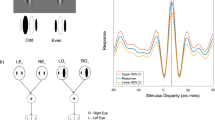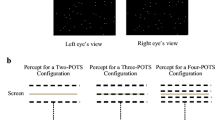Abstract
Unambiguous dots (having one binocular disparity) when inserted in an ambiguous random-dot stereogram (with multiple disparity values) could pull the ambiguous percept. The unambiguous bias carried that ambiguous depth percept whose disparity was nearest to the disparity of the bias. The closer the disparities were to each other, the stronger the pulling effect that was observed. Even a physical bias of 4% density was adequate to overcome the natural bias of most observers. The stimulus duration had to be over 50 msec to provide a strong pulling effect. In all experiments the stimulus duration was 160 msec or shorter, indicating that the pulling effect was a product of neural interactions, rather than convergence movement of the eyes. As a result of these findings a parallel model of stereopsis has been proposed, which extends the spring-coupled dipole model of Julesz (1971).
Similar content being viewed by others
References
Bough, E. W.: Stereoscopic vision in macaque monkey: a behavioral demonstration. Nature (Lond.)225, 41–42 (1970)
Breitmeyer, B., Julesz, B., Kropfl, W.: Dynamic random-dot stereograms reveal an up-down anisotropy and a left-right isotropy between cortical hemifields. Science187, 269–270 (1975)
Cowey, A., Parkinson, A. M., Warnick, L.: Global stereopsis in rhesus monkeys. Quart. J. Exp. Psychol.27, 93–109 (1975)
Dev, P.: Segmentation processes in visual perception: a cooperative neural model. COINS Techn. Report 74C-5, Amherst, Mass.: Computer and Information Sciences, Univ. of Massachusetts. (1974)
Fender, D. H., Julesz, B.: Extension of Panum's fusional area in binocularly stabilized vision. J. Opt. Soc. Amer.57, 819–30 (1967)
Hubel, D. H., Wiesel, T. N.: Stereoscopic vision in macaque monkey. Nature (Lond.)225, 41–42 (1970)
Julesz, B.: Binocular depth perception of computergenerated patterns. Bell Syst. Techn. J.39, 1125–62 (1960)
Julesz, B.: Towards the automation of binocular depth perception (AUTOMAP-1). Proceedings of the IFIPS Congress Munich, 1962, (ed.) Popplewell, C. M. Amsterdam: North Holland 1963
Julesz, B.: Binocular depth perception without familiarity cues. Science145, 356–62 (1964)
Julesz, B.: Foundations of Cyclopean Perception, Univ. of Chicago Press 1971
Nelson, J. I.: Globality and stereoscopic fusion in binocular vision. J. theor. Biol.49, 1 (1975)
Richards, W.: Anomalous stereoscopic depth perception. J. Opt. Soc. Amer.61, 410–414 (1971)
Sperling, G.: Binocular vision: A physical and neural theory.J. Amer. Psychol. 83, 461–534 (1970)
Author information
Authors and Affiliations
Additional information
Present address till Oct. 1, 1976: Prof. Dr. Bela Julesz
Rights and permissions
About this article
Cite this article
Julesz, B., Chang, J.J. Interaction between pools of binocular disparity detectors tuned to different disparities. Biol. Cybernetics 22, 107–119 (1976). https://doi.org/10.1007/BF00320135
Received:
Issue Date:
DOI: https://doi.org/10.1007/BF00320135




